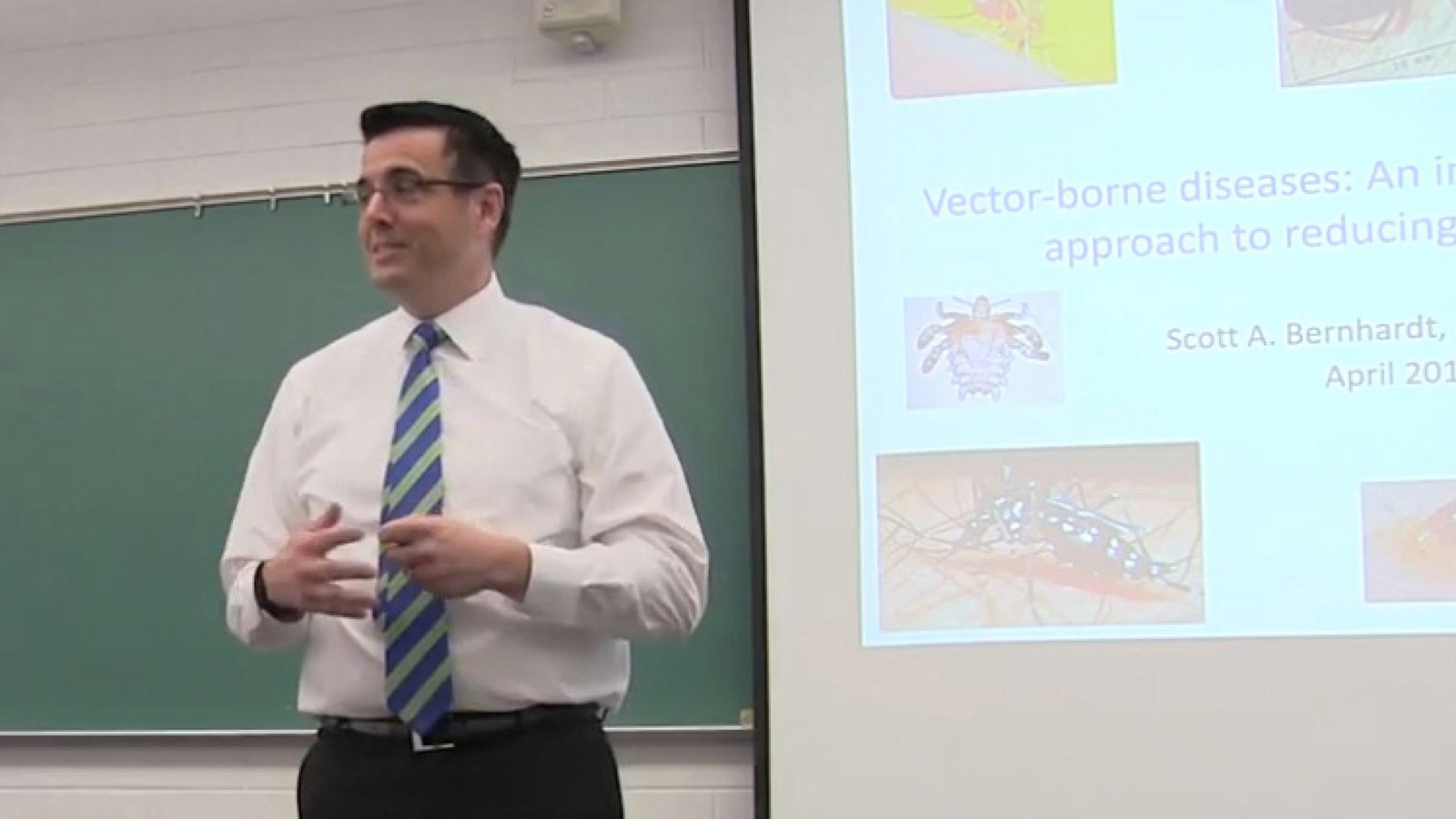USU Epidemiologist Helping Bear River Health with COVID-19 Case Investigations
By Mary-Ann Muffoletto |
In a 2019 lecture, USU Public Health faculty member Scott Bernhardt addresses vector-borne diseases. The epidemiologist is part of Utah's Medical Reserve Corps, helping the Bear River Health Department investigate a recent surge of COVID-19 cases.
Utah State University epidemiologist Scott Bernhardt is among Utah Medical Reserve Corps volunteers helping the Bear River Health Department gain control of a sudden surge in COVID-19 cases that hit northern Utah’s Cache Valley and surrounding areas in early June.
“I reached out to the health department earlier in the year to offer my expertise in epidemiology,” says Bernhardt, professional practice assistant professor in the USU Department of Biology’s Public Health Program, who was a postdoctoral fellow with the Centers for Disease Control, at the agency’s Atlanta headquarters, from 2002-2004 and from 2009-2010.
Initially, he says, few cases were detected within the Bear River Health District, which includes Cache, Box Elder and Rich Counties, so the department had little need for his assistance. And then came an outbreak following Memorial Day Weekend.
The district’s caseload leapt to triple digits and the department quickly enlisted the USU faculty member’s help. Bernhardt is assisting with case investigations at a Hyrum meat packing facility, where a large number of the new cases have been detected. In addition, he’s advising managers at other area facilities on preventive practices.
“I’m talking, by phone, with people who’ve tested positive for COVID-19 and advising them on how to limit spread of the disease,” he says. “I’m also conducting contact tracing, which involves finding out who they’ve been in contact with, how they might have contracted the disease and anyone they may have exposed to the virus.”
Bernhardt began watching the spread of COVID-19 well before it arrived in Utah and even before the illness had a name. The scientist says he’s always on the lookout for news of emerging public health trends and infectious disease outbreaks, including vector-borne illnesses, in which he specializes.
“I’m constantly seeking real-world cases for my epidemiology class lectures and material to inform my research,” he says. “When I started hearing about an infectious disease spreading through China’s Wuhan province in late 2019, it caught my attention.”
Descriptions of the illness reminded Bernhardt of the 2002-2003 SARS (Severe Acute Respiratory Syndrome) outbreak, which occupied much of his duties during his CDC tenure.
“The symptoms were similar and transmission seemed similar, but the level of transmission appeared much worse,” he says. “We learned that, like SARS, the new illness, eventually named COVID-19, was caused by a novel coronavirus. SARS sparked serious concern, but the disease was contained within about a year and total cases, worldwide, reached a few thousand. Cases of COVID-19 quickly eclipsed that within weeks.”
At the start of USU’s Spring 2020 semester, Bernhardt began discussing the mysterious illness in his lectures.
“Initially, this coronavirus seemed a world away to my students and elicited little concern regarding their personal safety,” he says.
That changed, of course, as the scope of the outbreak escalated and, in March 2020, as face-to-face classes at Utah State, and around the world, were cancelled.
“We still have much to learn about the virus and a vaccine could take much longer than we hope,” Bernhardt says. “But what we do know is limiting social mixing slows the spread.”
Cache Valley, he says, has the advantage of lots of space, relative to places such as New York City and Italy’s urban centers, where COVID-19 spread like wildfire.
“But that’s made us somewhat complacent and dismissive of the disease’s risks,” Bernhardt says. “As the state went from orange to yellow, we saw a change in people’s behaviors. They let their guard down and spread of the virus followed.”
A major challenge facing public officials, private employers and valley residents, he says, is balancing public health risks versus economic effects.
“Public health never happens in a vacuum,” Bernhardt says. “People need to feed their children and pay the rent, yet this is a very dangerous virus. Tough decisions will have to be made.”
As challenging as circumstances are, he says, it’s exactly the kind of situation he and colleagues in USU’s Public Health program strive to prepare students to face.
“I’m grateful to be part of program that provides students with rigorous, real-world instruction that equips them to manage these kinds of scenarios,” Bernhardt says. “Our graduates will be the decision-makers, who will lead efforts with no easy solutions.”
Utah's Bear River Health Department provides services to Cache, Box Elder and Rich Counties. The department enlisted help from USU epidemiologist Scott Bernhardt in case investigation and contact tracing of a recent COVID-19 outbreak. M. Muffoletto.
WRITER
Mary-Ann Muffoletto
Public Relations Specialist
College of Science
435-797-3517
maryann.muffoletto@usu.edu
CONTACT
Scott Bernheardt
Professional Practice Assistant Professor
Department of Biology
435-535-6044
scott.bernhardt@usu.edu
TOPICS
Community 450stories Faculty 317stories Health 312stories Biology 169stories COVID-19 157storiesComments and questions regarding this article may be directed to the contact person listed on this page.









